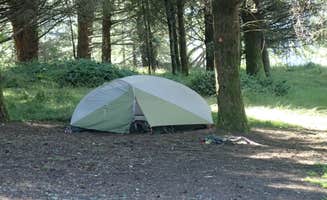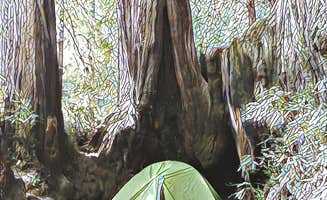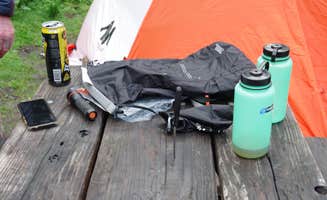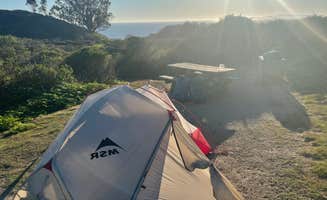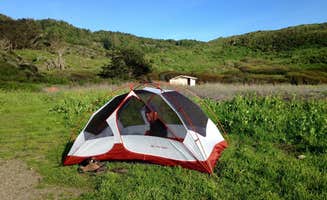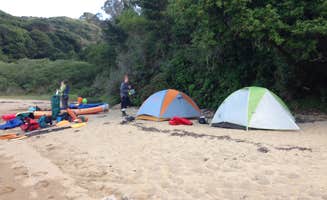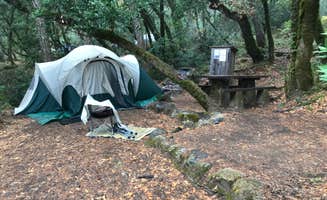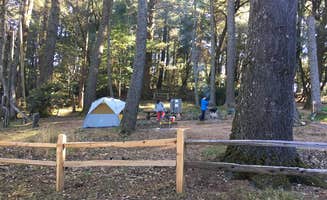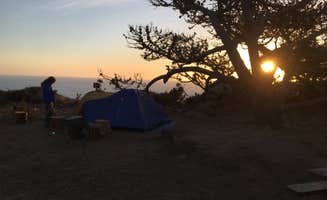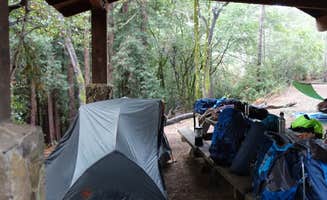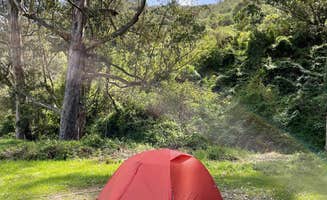Point Reyes National Seashore and Mount Tamalpais State Park offer extensive backcountry tent camping opportunities near Olema, California, with seasonal challenges that vary throughout the year. Winter brings consistent rainfall averaging 37 inches annually, while summer introduces persistent coastal fog that can create damp camping conditions even when inland areas remain sunny. Most hike-in campgrounds require advance planning due to their popularity and limited site availability.
What to do
Tide pool exploration: 2-mile hike from Coast Campground to nearby beaches reveals diverse marine ecosystems. "The beach was sandy and beautiful, not that many people around" according to a visitor at Coast Campground, who also mentioned easy beach access just "2 min walk to beach, with amazing views of the cliffs and seashore."
Sunrise beach hikes: Schedule morning walks to beat crowds at popular destinations. One camper at Glen Campground noted "the hiking through the redwoods was magnificent. The streams were running, and the undergrowth - particularly the ferns - were a fluorescent green." Another hiker found "hiking trails leading to the sea" directly from the campground.
Winter stargazing: Clear nights reveal exceptional views despite proximity to urban areas. A camper at Steep Ravine Campground observed "if you like huckleberries - the trail is lined with them" and "when there is no fog there are great sunsets." Another camper noted the "night had beautiful stars with no artificial light" when describing their experience.
What campers like
Protected coastal campsites: Wind barriers provide comfortable camping despite coastal conditions. One camper at Coast Campground appreciated being "near the beach but protected from the coastal wind" while another noted that sites are "protected from the wind and ocean by a nice hill."
Mid-week solitude: Less crowded experience when avoiding weekend reservations. A camper at Haypress Campground described it as a "hidden gem" with "very little privacy between sites but the couple times I have been here it was not full." Another noted "The night had beautiful stars with no artificial light. No road noise."
Creek-side camping options: Natural water features enhance several campgrounds. A Bootjack Campground visitor mentioned "many sites are next to the creek" and that it's "usually quiet and peaceful." Sky Campground users noted sites "surrounded by lush vegetation and have trees that provide shade and protection against the wind."
What you should know
Trail conditions vary seasonally: Winter rains create muddy paths but lush landscapes. A Glen Campground visitor warned "Site 8 gets 0 sun. Mud/cold. Not fun," while another camper noted "Some sites are dry and get some sun."
Food storage requirements are strict: Wildlife actively targets campsites. One camper at Sky Campground warned to "be aware of small field mice that can get into the food storage boxes. Bring some steel wool or a critter-proof container to keep food safe, even inside the locker."
Water access varies significantly: Plan accordingly for each campground. At Haypress Campground, campers must "bring your own water" as there is "no water" available. Another camper advised "Pack in the water you need (if push comes to shove you can head back to the main trail to get more)."
Fire restrictions differ by location: Check current rules before arrival. At Coast Campground, you can get "a permit for a beach fire but couldn't find enough drift wood to make it last," while at Glen Campground, "wood fires are not permitted" but sites have "charcoal barbecues."
Tips for camping with families
Choose shorter hike-in options: Several campgrounds offer easier access for children. A visitor to Pantoll Campground noted "You can hike to, bike to, take the bus to, or even drive to this campground" making it accessible for various transportation methods. Another camper described it as "A hike-in only campground. But has pit toilets, potable water."
Select more secluded sites: Numbered sites with more privacy reduce disturbances. At Wildcat Campground, "sites 6 &/or 7 provide a little more seclusion" according to an experienced camper. Another noted that "Site 7 is a bit protected by trees and is the closest to the beach."
Schedule adequate hiking time: Allow extra time for children on trails. A family at Sky Campground shared: "For someone who almost never has a chance to hike and stupidly overpacked for a one night stay, the ~2 mile trail to get to Sky Camp was pretty nice!" They also noted "many of the sites feature beautiful historic stone grills."
Prepare for wildlife encounters: Educational but requires preparation. A camper at Wildcat Campground warned to be "on the lookout for small vermin running around the fields and looking to snag any food you've left out" while another observed raccoons being "everywhere at night! They can unzip coolers those little zippable coolers."
Tips from RVers
No direct RV camping options: All tent-only campsites require hiking or walking in. However, Bootjack Campground visitors note "The sites are very close to the parking lot (and the main road) so it was easy to haul everything up and back from the car." This allows RV owners to park nearby and walk a short distance to tent sites.
Day-use options: RV owners can park at designated trailheads. Hikers at Haypress Campground mentioned it's "about a 0.75 mile hike from the Tennessee Valley trail head" with parking available for day use while camping in the tent-only area.


